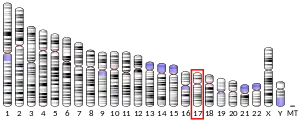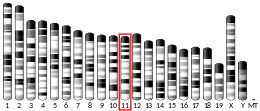RNF43
Ring finger protein 43 is a protein that in humans is encoded by the RNF43 gene. [5]
| RNF43 | |||||||||||||||||||||||||||||||||||||||||||||||||||
|---|---|---|---|---|---|---|---|---|---|---|---|---|---|---|---|---|---|---|---|---|---|---|---|---|---|---|---|---|---|---|---|---|---|---|---|---|---|---|---|---|---|---|---|---|---|---|---|---|---|---|---|
| |||||||||||||||||||||||||||||||||||||||||||||||||||
| Identifiers | |||||||||||||||||||||||||||||||||||||||||||||||||||
| Aliases | RNF43, RNF124, URCC, ring finger protein 43, SSPCS | ||||||||||||||||||||||||||||||||||||||||||||||||||
| External IDs | OMIM: 612482 MGI: 2442609 HomoloGene: 37742 GeneCards: RNF43 | ||||||||||||||||||||||||||||||||||||||||||||||||||
| |||||||||||||||||||||||||||||||||||||||||||||||||||
| |||||||||||||||||||||||||||||||||||||||||||||||||||
| |||||||||||||||||||||||||||||||||||||||||||||||||||
| |||||||||||||||||||||||||||||||||||||||||||||||||||
| |||||||||||||||||||||||||||||||||||||||||||||||||||
| Wikidata | |||||||||||||||||||||||||||||||||||||||||||||||||||
| |||||||||||||||||||||||||||||||||||||||||||||||||||
Function
The protein encoded by this gene is a RING-type E3 ubiquitin ligase and is predicted to contain a transmembrane domain, a protease-associated domain, an ectodomain, and a cytoplasmic RING domain. This protein is thought to negatively regulate Wnt signaling, and expression of this gene results in an increase in ubiquitination of frizzled receptors, an alteration in their subcellular distribution, resulting in reduced surface levels of these receptors. Alternative splicing results in multiple transcript variants encoding different isoforms. [provided by RefSeq, Mar 2015]. A nuclear function for the protein has also been proposed but recently it was shown that this is an artifact, nuclear staining being an artifact of the antibodies employed.[6] Cancer-associated RNF43 mutations lead to activation of β-catenin signaling through aberrantly increasing Wnt-receptor levels at the membrane. Importantly, inactivating N-terminal RNF43 mutations render cancer cells sensitive to Wnt antagonists, but mutations elsewhere do not.[7]
References
- GRCh38: Ensembl release 89: ENSG00000108375 - Ensembl, May 2017
- GRCm38: Ensembl release 89: ENSMUSG00000034177 - Ensembl, May 2017
- "Human PubMed Reference:". National Center for Biotechnology Information, U.S. National Library of Medicine.
- "Mouse PubMed Reference:". National Center for Biotechnology Information, U.S. National Library of Medicine.
- "Entrez Gene: Ring finger protein 43". Retrieved 2018-02-21.
- Li S, Zhang R, Lavrijsen M, van den Bosch TP, Peppelenbosch MP, Smits R (2023). "Issues with RNF43 antibodies to reliably detect intracellular location". PLoS One. 18 (4): :e0283894. doi:10.1371/journal.pone.0283894. PMID 37023034.
- Li S, Lavrijsen M, Bakker A, Magierowski M, Magierowska K, Liu P, Wang W, Peppelenbosch MP, Smits R (2020). "Commonly observed RNF43 mutations retain functionality in attenuating Wnt/β-catenin signaling and unlikely confer Wnt-dependency onto colorectal cancers". Oncogene. 39 (17): :e0283894. doi:10.1038/s41388-020-1232-5. PMID 32103169.
Further reading
- Yagyu R, Furukawa Y, Lin YM, Shimokawa T, Yamamura T, Nakamura Y (November 2004). "A novel oncoprotein RNF43 functions in an autocrine manner in colorectal cancer". Int. J. Oncol. 25 (5): 1343–8. PMID 15492824.
- Sugiura T, Yamaguchi A, Miyamoto K (April 2008). "A cancer-associated RING finger protein, RNF43, is a ubiquitin ligase that interacts with a nuclear protein, HAP95". Exp. Cell Res. 314 (7): 1519–28. doi:10.1016/j.yexcr.2008.01.013. PMID 18313049.
- Shinada K, Tsukiyama T, Sho T, Okumura F, Asaka M, Hatakeyama S (January 2011). "RNF43 interacts with NEDL1 and regulates p53-mediated transcription" (PDF). Biochem. Biophys. Res. Commun. 404 (1): 143–7. doi:10.1016/j.bbrc.2010.11.082. hdl:2115/44929. PMID 21108931.
- Koo BK, Spit M, Jordens I, Low TY, Stange DE, van de Wetering M, van Es JH, Mohammed S, Heck AJ, Maurice MM, Clevers H (August 2012). "Tumour suppressor RNF43 is a stem-cell E3 ligase that induces endocytosis of Wnt receptors". Nature. 488 (7413): 665–9. Bibcode:2012Natur.488..665K. doi:10.1038/nature11308. PMID 22895187. S2CID 4386072.
- Ryland GL, Hunter SM, Doyle MA, Rowley SM, Christie M, Allan PE, Bowtell DD, Gorringe KL, Campbell IG (February 2013). "RNF43 is a tumour suppressor gene mutated in mucinous tumours of the ovary". J. Pathol. 229 (3): 469–76. doi:10.1002/path.4134. PMID 23096461. S2CID 24919944.
- Xing C, Zhou W, Ding S, Xie H, Zhang W, Yang Z, Wei B, Chen K, Su R, Cheng J, Zheng S, Zhou L (January 2013). "Reversing effect of ring finger protein 43 inhibition on malignant phenotypes of human hepatocellular carcinoma". Mol. Cancer Ther. 12 (1): 94–103. doi:10.1158/1535-7163.MCT-12-0672. PMID 23136185.
- Jiang X, Hao HX, Growney JD, Woolfenden S, Bottiglio C, Ng N, Lu B, Hsieh MH, Bagdasarian L, Meyer R, Smith TR, Avello M, Charlat O, Xie Y, Porter JA, Pan S, Liu J, McLaughlin ME, Cong F (July 2013). "Inactivating mutations of RNF43 confer Wnt dependency in pancreatic ductal adenocarcinoma". Proc. Natl. Acad. Sci. U.S.A. 110 (31): 12649–54. Bibcode:2013PNAS..11012649J. doi:10.1073/pnas.1307218110. PMC 3732970. PMID 23847203.
- Zou Y, Wang F, Liu FY, Huang MZ, Li W, Yuan XQ, Huang OP, He M (November 2013). "RNF43 mutations are recurrent in Chinese patients with mucinous ovarian carcinoma but absent in other subtypes of ovarian cancer". Gene. 531 (1): 112–6. doi:10.1016/j.gene.2013.08.054. PMID 24001777.
- Zebisch M, Xu Y, Krastev C, MacDonald BT, Chen M, Gilbert RJ, He X, Jones EY (2013). "Structural and molecular basis of ZNRF3/RNF43 transmembrane ubiquitin ligase inhibition by the Wnt agonist R-spondin". Nat Commun. 4: 2787. Bibcode:2013NatCo...4.2787Z. doi:10.1038/ncomms3787. PMC 3905715. PMID 24225776.
This article incorporates text from the United States National Library of Medicine, which is in the public domain.



